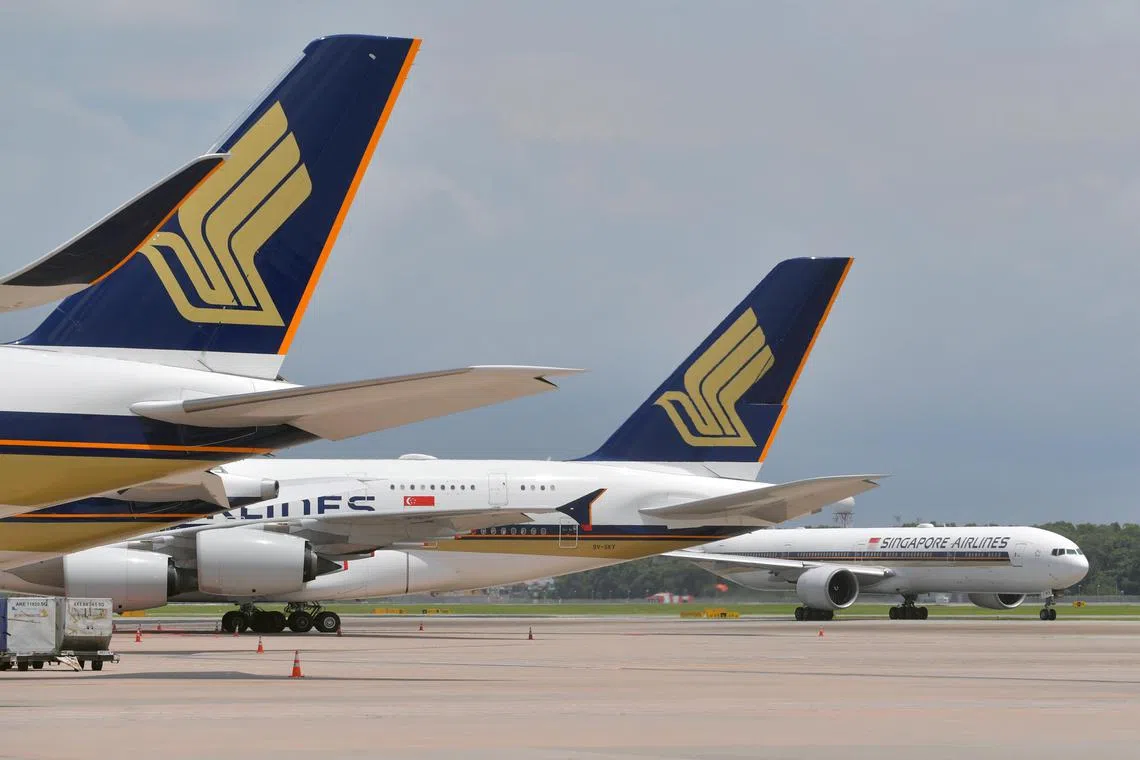CAAS flags ‘shortcomings’ in 2022 incident where SIA jet forced to land in Batam with very low fuel
Sign up now: Get ST's newsletters delivered to your inbox

An investigation report on the incident said the flight crew appeared to prefer landing in Changi, even though an earlier diversion would have allowed them to land in Batam under better conditions.
ST FILE PHOTO
Follow topic:
SINGAPORE – Investigations into a 2022 incident where a Singapore Airlines plane made an unscheduled landing in Batam with critically low levels of fuel found that those involved could have handled the situation better.
Flight SQ319, which was heading to Singapore from London on Oct 25, 2022, was diverted from Changi Airport due to bad weather at the time.
An investigation report on the incident said the flight crew appeared to prefer landing in Changi, even though an earlier diversion would have allowed them to land in Batam under better conditions.
The weather over Batam later deteriorated, forcing the pilots who had already declared a fuel emergency to abort their initial approach.
One of the pilots then tried to perform an automated landing from the other direction and was startled by a message from his flight display saying that he was not permitted to do so.
The pilots also did not realise that they had failed to contact the air traffic control tower in Batam, and did not get clearance to land on one of their initial attempts. The plane landed only on their fourth try.
There were 280 people on board Flight SQ319 at the time, according to the incident report by the Transport Safety Investigation Bureau (TSIB) published on Sept 25. No one was injured, and there was no damage to the Boeing 777-300ER aircraft.
On Saturday, in response to queries, the Civil Aviation Authority of Singapore (CAAS) said there were shortcomings in the way that the flight diversion was handled.
However, there were no regulatory breaches by SIA, said Mr Alan Foo, senior director of the safety regulation group at CAAS.
According to CAAS safety regulations, which apply to any aircraft operated by a Singapore operator, a flight must be planned such that it is able to land at its destination with a certain amount of fuel left.
Called “final reserve fuel”, or FRF, this is the absolute minimum required for an aircraft to remain airborne safely, in case of delays.
The pilot in command of the plane must monitor fuel levels throughout the flight and take appropriate action, such as adjusting the flight route, if the FRF may be depleted.

A Flightradar24 image shows the flight path of Flight SQ319 on Oct 25, 2022.
PHOTO: FLIGHTRADAR24
According to CAAS, landing with fuel levels lower than the FRF requirement under unforeseen circumstances does not constitute a regulatory breach.
Since the October 2022 incident, Mr Foo said CAAS has worked with SIA to put in place mitigating measures to prevent a recurrence.
This includes getting planes to carry more fuel and reinforcing the procedures for diverting planes to alternative airports during bad weather.
Without providing more details, an SIA spokesman said that the airline has “proactively and swiftly” incorporated the lessons learnt from the incident into its training, policies and processes.
“SIA also engaged with other stakeholders in the aviation community to improve the flow and accuracy of information during the management of similar situations in the future,” said the spokesman.
According to the TSIB report, Flight SQ319 was scheduled to arrive in Singapore at 4.55pm on Oct 25, 2022, and the planned alternative destination airports were Paya Lebar Air Base, Kuala Lumpur International Airport, and Senai International Airport in Johor.
The plane had 106,164kg of fuel before departing Heathrow Airport the day before, and the pilots were a 55-year-old captain who had a total flying time of 14,371 hours, and a 31-year-old first officer with a total flying time of 2,262 hours.
TSIB said the pilots were satisfied that there was no need for additional fuel as there was no indication that weather along the flight route would result in a large diversion, and the thunderstorms at Changi forecast for the time of arrival were not severe enough to prevent the plane from landing.
Monsoon rains affecting South-east Asia then resulted in Singapore experiencing its wettest October in four decades.
At about 4pm, while the plane was in the air near Mersing, Malaysia, the pilots were told to expect to land on Runway 20R at Changi Airport. At the time, the estimated fuel level of the jet on landing was 7,000 kg, which was above the FRF requirement of 3,024 kg.
Five minutes later, the crew were told that a strong tailwind and heavy rain would delay arrivals to Changi, and that there was also heavy rain over Paya Lebar Air Base and Senai International Airport. The weather at Batam airport appeared fine.
As the weather in Singapore continued to get worse, all landings were temporarily held off to assess the situation.
At 4.29pm, the SQ319 flight crew were told to head to a waypoint near Batam and hold there.
The pilots learnt en route that the weather at Batam airport was still clear at the time.
They also informed Singapore air traffic control that they could execute a holding manoeuvre only once, as they would be down to emergency fuel after that. As they were completing this, the pilots asked for an update on Changi, and said they could do another round before diverting to Batam.
At 4.42pm, the pilots were told that Changi Airport was still unable to accept arrivals, and air traffic control was in the midst of coordinating a diversion to Batam. Two minutes later, the flight crew made the decision to divert, even as it continued to ask if Changi could accept arrivals.
At 4.53pm, the crew declared “Mayday Fuel”, as the estimated fuel level on landing at Batam had now hit the FRF limit. The plane was given priority to land shortly after. By then, the weather at Batam had also deteriorated.
After missing their initial approach into the airport due to strong winds, the flight crew tried at about 5.05pm to land on Runway 04 using the plane’s automated landing system, which is typically used in low visibility.
But the pilots had to perform a go-around after receiving a “No Autoland” message, which, coupled with the low fuel situation, likely intensified their workload, TSIB said.
The flight crew was also told at the time to contact Batam airport’s control tower, but the tower reported that the crew did not do so, and the air traffic controllers could not see the plane because of the heavy rain.
At about 5.10pm, while repositioning the plane for another landing attempt, one of the pilots was told that the visibility at Runway 22 was better.
But the pilot informed controllers that there was insufficient fuel to reposition the plane again, and that his next landing attempt “had to be successful”.
This attempt failed after the crew got a warning that the plane was descending too quickly, and the pilot had to perform another go-around before finally touching down at 5.19pm.
TSIB said the fuel remaining on the plane was “significantly below the FRF of 3,024kg”, but it did not say exactly how much fuel was left. When asked, SIA and CAAS declined to reveal this figure.
In its analysis, TSIB noted SIA’s opinion that the flight crew could have made a better decision if it had been given “pertinent information”, such as being explicitly told that Changi Airport was holding off on arrivals. However, the bureau felt that the repeated information on Changi being unable to accept arrivals should have been interpreted that a landing there was not assured. It said three other aircraft were given similar information, and their crew were able to make a decision to divert earlier. TSIB also noted that one effect of climate change is more intense and frequent storms, and this is expected to make the operating environment for pilots more unpredictable.
“The events in this occurrence suggest that it may be prudent for pilots to interpret operating procedures in a more conservative manner,” it added.
“This will allow pilots to make an earlier decision to divert, with higher safety margins, especially when weather conditions are favourable, to increase the chances of conducting a safe landing.”


